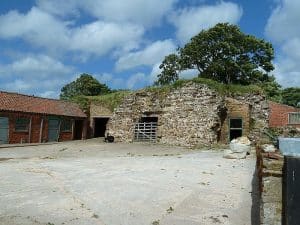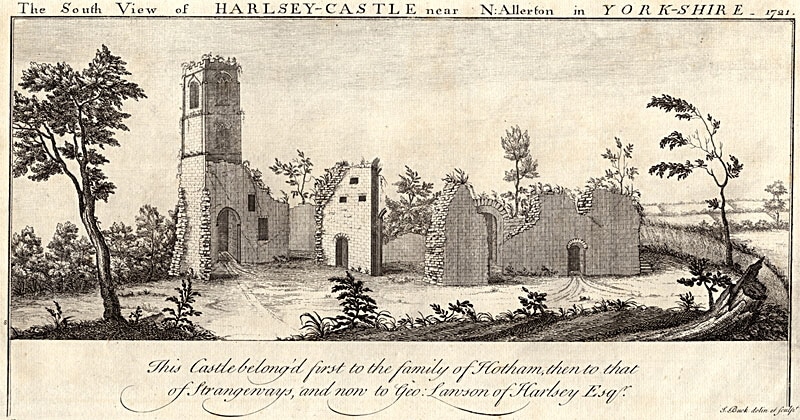Harsley Castle
Harsley Castle is situated to the north east of Northallerton,. It is close to junctions that link Northallerton and Thirsk with more northerly locations such as Yarm, Guisborough, and Middlesborough. This was an important strategic area. Other castles protect these routes, Sigston Castle is just two miles to the South and Whorlton Castle is to the north. Many other fortifications from the Medieval era are also found in this area. Little is recorded of the origins of Harsley Castle. Its written records date from the sites purchase by Sir James Strangeways in 1423.
Harsley Castle
Whorlton, in Cliveland, was the principal house of the Lord Menell, which sence came to Master Strangwayes in particion.
Leland, Itineraries
Historic England describe the castle as being:
Early C15 and C19. Stone, rendered, pantile roof. 2 storeys, 4 bays. Right-hand bay has a lower roof. To bay 2 a 4-panel door with overlight set in plain doorcase with pilasters, frieze and cornice .
Details of the Harsley site
It is likely that the structure that is noted under the ownership of the Strangeways family was a development of earlier buildings. The Pevsner Guide to Architecture notes:
An almost rectangular enclosure of 4 1/2 acres, with a 30ft wide ditch on three sides and terraces for defence on the west. Slight remains exist of an inner enclosure, including three cellars with rubble-vaulted pointed roofs which may be the basement of a later keep.
The remains of the Keep are now incorporated into a Farm building. The upper floors of the castle are long since gone. The moated area is largely filled, being used for farming purposes. The castle itself was added to the Heritage at risk register which has resulted in a grant from Historic England that has enabled the remains to be made wind and waterproof [source].

The Strangeways Family and Harsley Castle
James Strangeways purchased Harsley in 1423. His son, also Sir James Strangeways, inherited the Manor and Castle in 1443. The latter of these had a prominent role in regional and national politics in the Wars of the Roses.
Born c1410, Sir James Strangeways was clearly quite gifted and well thought of. He was appointed as High Sheriff of Yorkshire on three occasions: in 1446, 1453 and again in 1469. Similarly, he was returned as a Knight of the Shire to Parliament on three occasions: 1449, 1460 and lastly at the first of Edward IV‘s Parliaments in 1461-62.
James was the first Speaker of the Commons appointed during King Edward IV’s reign. This suggests that he was highly thought of by those close to the Crown, including the Neville affinity with whom he had dealings through Harsley’s proximity to Neville held manors and Castles such as Middleham and Sheriff Hutton.
Sir James Strangeways in the Wars of the Roses
As noted above, Sir James held administrative positions in Yorkshire as the Wars of the Roses approached. These continued into the Yorkist era. He was a Yorkist and was closely allied with the Earl of Salisbury, then Earl of Warwick. This reflects the regional ties that men of stature in Yorkshire had in the 1450s: most were allied to either the Neville or Percy families. Sir James Strangeways was an indentured retainer of the Earl of Salisbury, receiving an annual fee of £6 13s 4d for his services: more than any other retainer from the local gentry [p125 Pollard]. He had also contracted in 1447 to ‘be belast and witholden with the earl for life against all folks saving Katherine duchess of Norfolk, Robert Bishop of Durham and his kin and allies… at and within the third degree of marriage [p132 Pollard].
Involvement in Battles
Unreferenced articles suggest that Sir James fought in the First Battle of St. Albans. He is noted in the Paston Letters having fought in the Battle of Wakefield – with a suggestion that he was reported dead. He is also believed to have fought in the Battle of Towton. Whether he was present or not at Towton, he was clearly important within the Yorkist hierarchy. It was he who was returned as Speaker of the House at Edward IV’s first parliament. He also received Commissions to track down a number of Lancastrian nobles.
Harsley Castle Links
Historic England – Harsley Castle Farmhouse official listing. And a separate listing for the 15th century stables.
Gatehouse Gazetteer – Sources and references on Harsley Castle.
Moors Knowledge – Harsley Castle, a brief description.
ARCHI – Database of Archaeological resources for Harsley Castle along with contet maps.
Oxford Dictionary of National Biography – Sir James Strangeways. Note that the earlier edition of the Dictionary of National Biography, cited by Wikipedia, has errors which are corrected in the most recent version. UK readers can get free access to this subscription site through use of a UK library card from most local authorities.
